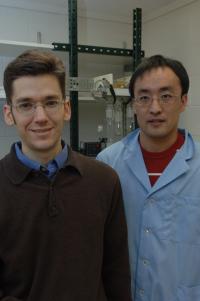|
Related Topics: |
|
|
|
Current News |
|
Chemistry A to Z |
|
About Internetchemistry |
Retrospective Rubber Remembers Its Old Identities |
|
The material, described in the journal Advanced Materials, forms a new class of shape-memory polymers, which are materials that can be stretched to a new shape and will stay in that form until heated, at which time they revert to their initial shape. Unlike conventional shape-memory polymers, however, the new material is transparent, rubbery, and most importantly, engineers will be able to control the speed at which it returns to its original shape. Other shape memory polymers use crystallization to hold a temporary shape, which often makes them opaque, hard, and brittle in their frozen states, and this can limit their use. |
|
"At higher temperatures the material stretches like a rubber band, but, at lower temperatures, it stiffens up," says Mitchell Anthamatten, assistant professor of chemical engineering and inventor of the material. "This property can be used to temporarily hold the material in a deformed shape; and its original shape can be recalled by heating. Imagine an optical lens that can be triggered to change shape, a face-mask that can fit any user, or a biomedical implant that changes shape slow enough for a surgical procedure." The new rubber functions differently than conventional shape-memory materials by using "sticker groups" - hydrogen bonding groups that form temporary bonds. These sticker groups break and reform constantly. It's akin to tearing a net apart only to find that new knots have formed between different strands. When the material is stretched, new bonds form that hold the material, temporarily, in its deformed shape. Creating the rubber with different amounts of sticker groups controls the rate at which the rubber returns to its original shape. With this control, Anthamatten envisions applications that today's shape-memory polymers simply can't fulfill. "The pressure at which you hold together a sutured wound determines a lot about how it will heal," says Anthamatten. "This polymer could be made into a thread that responds precisely to body temperature, tightening the sutures to the perfect pressure." Anthamatten is currently investigating how dyes diffuse through his networks. "We expect the rate of dye diffusion to increase with temperatures," says Anthamatten. This property may enable "smart" labels that account for time and temperature and can inform customers when products are about to expire. "We may not always have to rely on the expiration date. What if our milk was not refrigerated properly? What if the air conditioner failed for some time at the pharmacy? People want to know that their products are fresh." One aspect of the clear rubber that surprised Anthamatten was how easy it is to make. "It's ridiculously simple," he says, "and we're fascinated by how small modifications lead to major changes in how the material behaves." |
|
|
|

